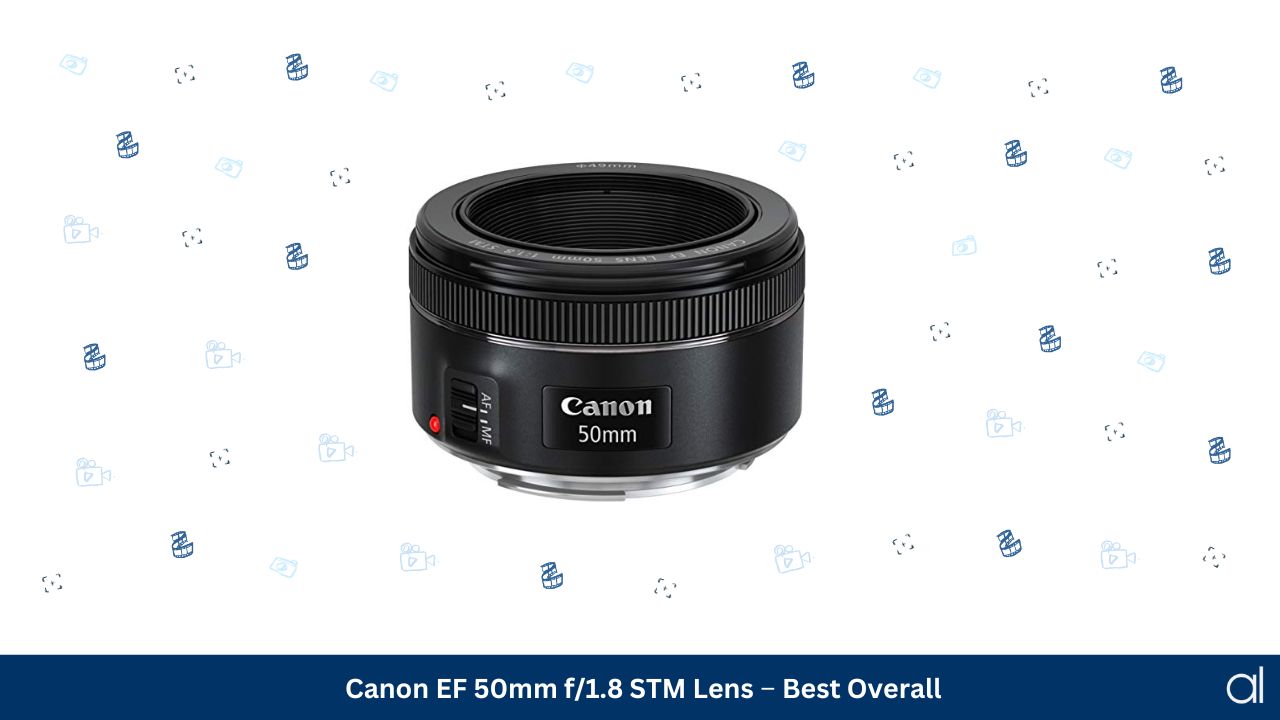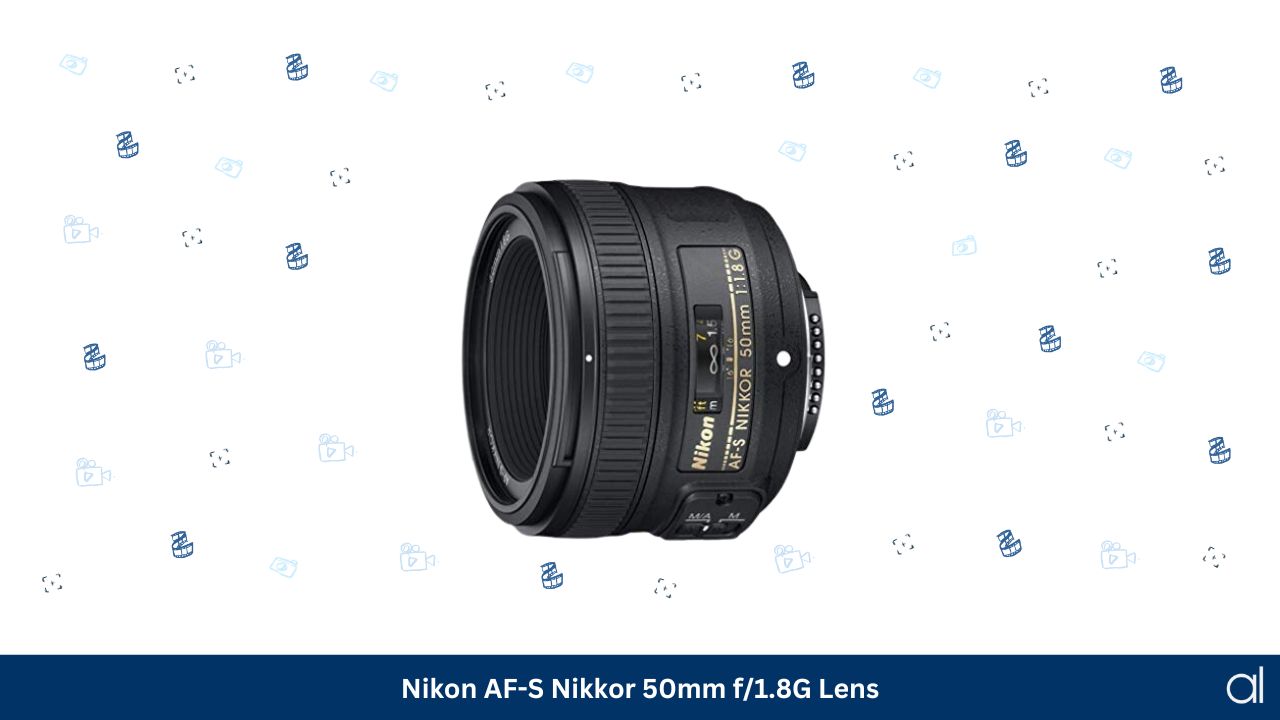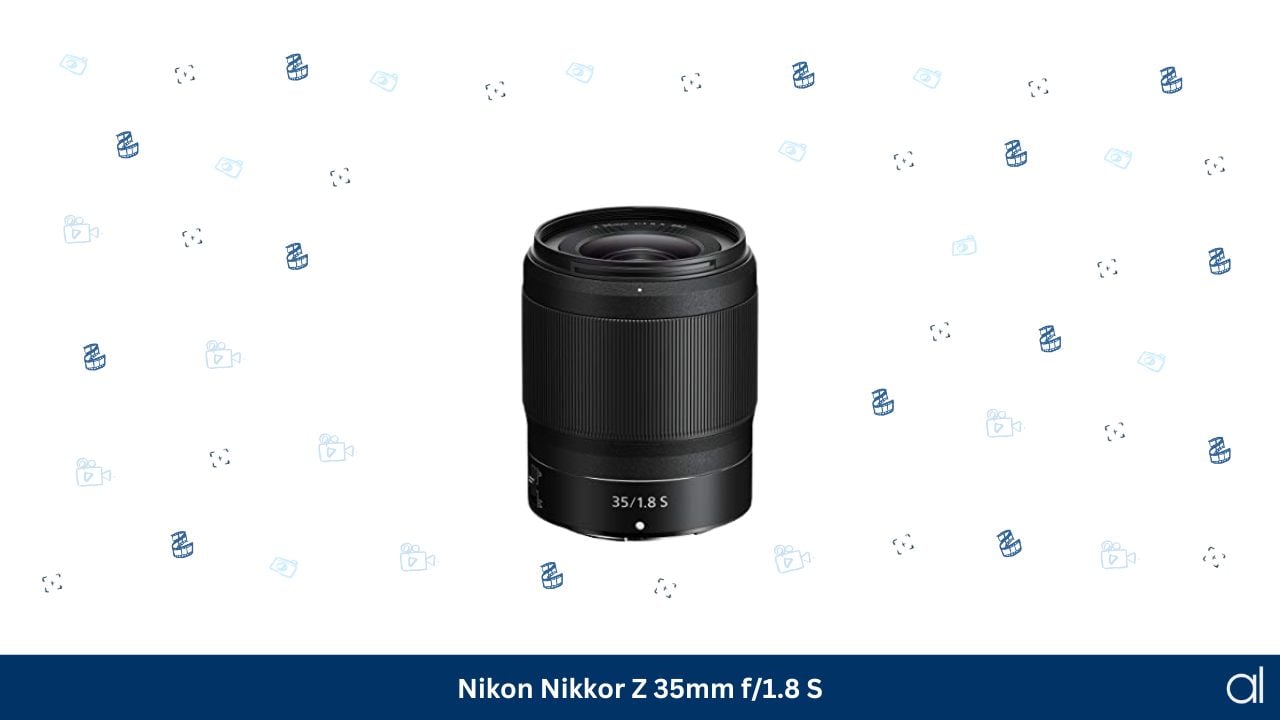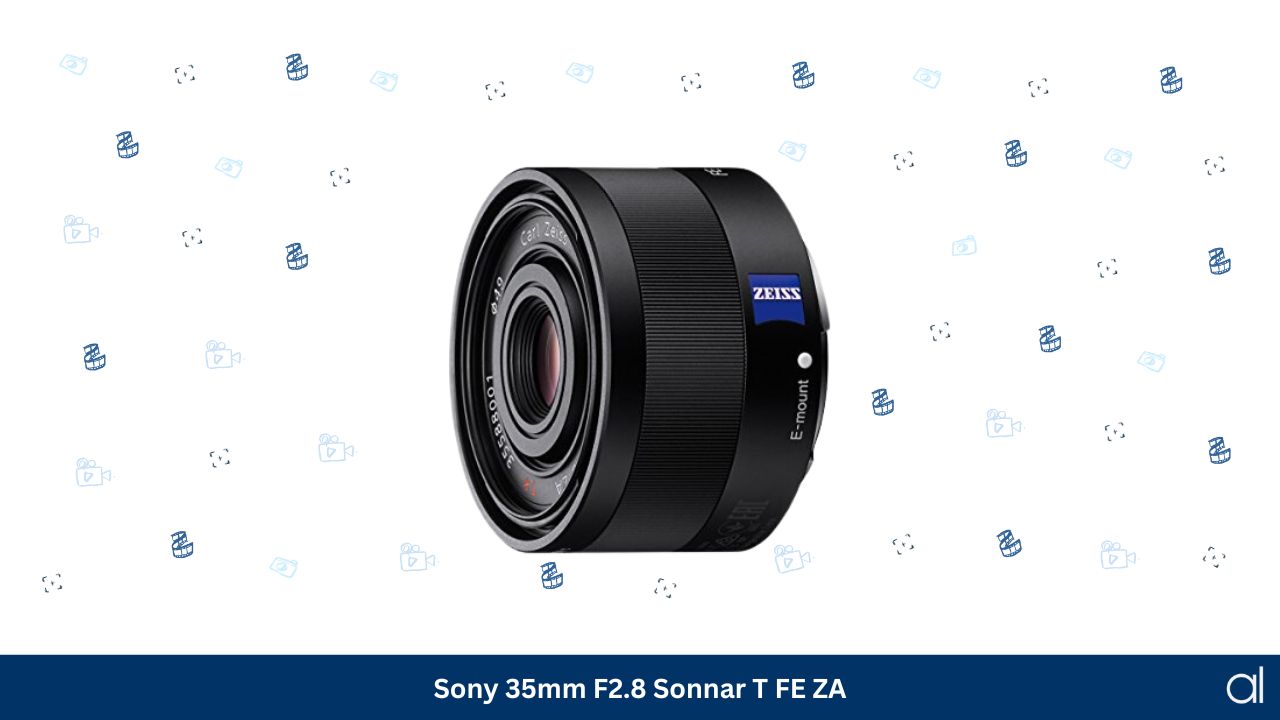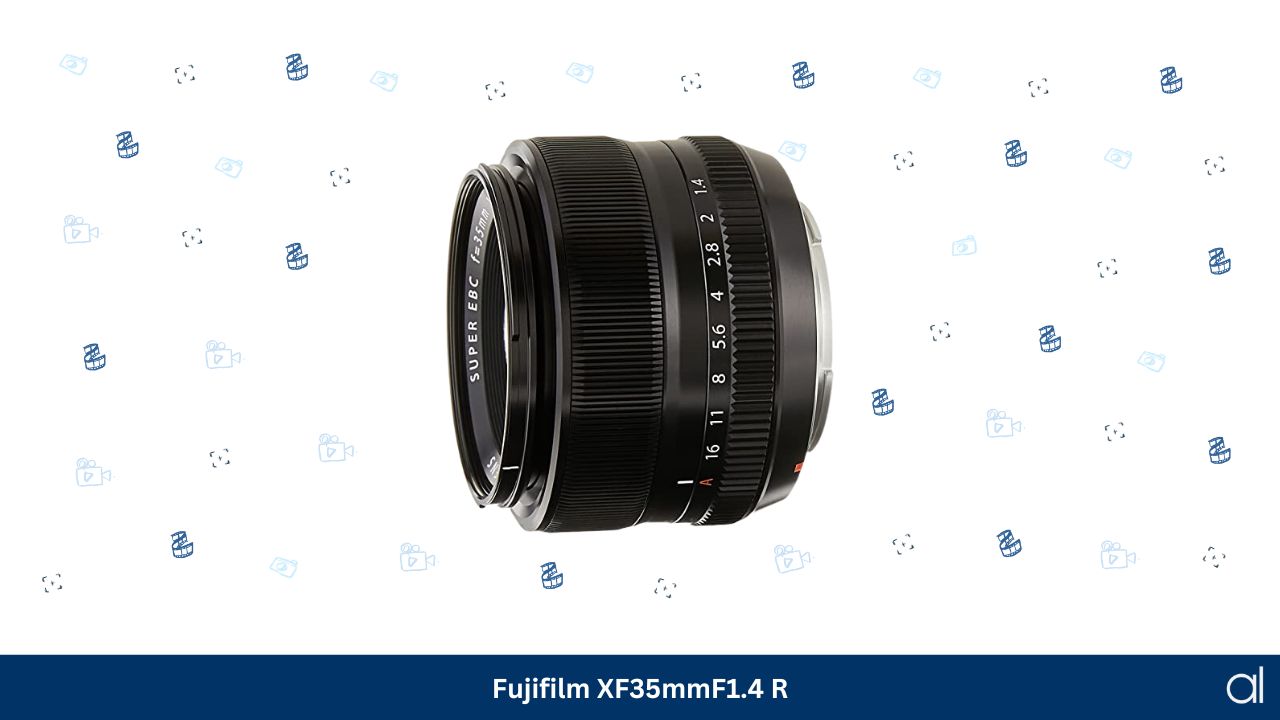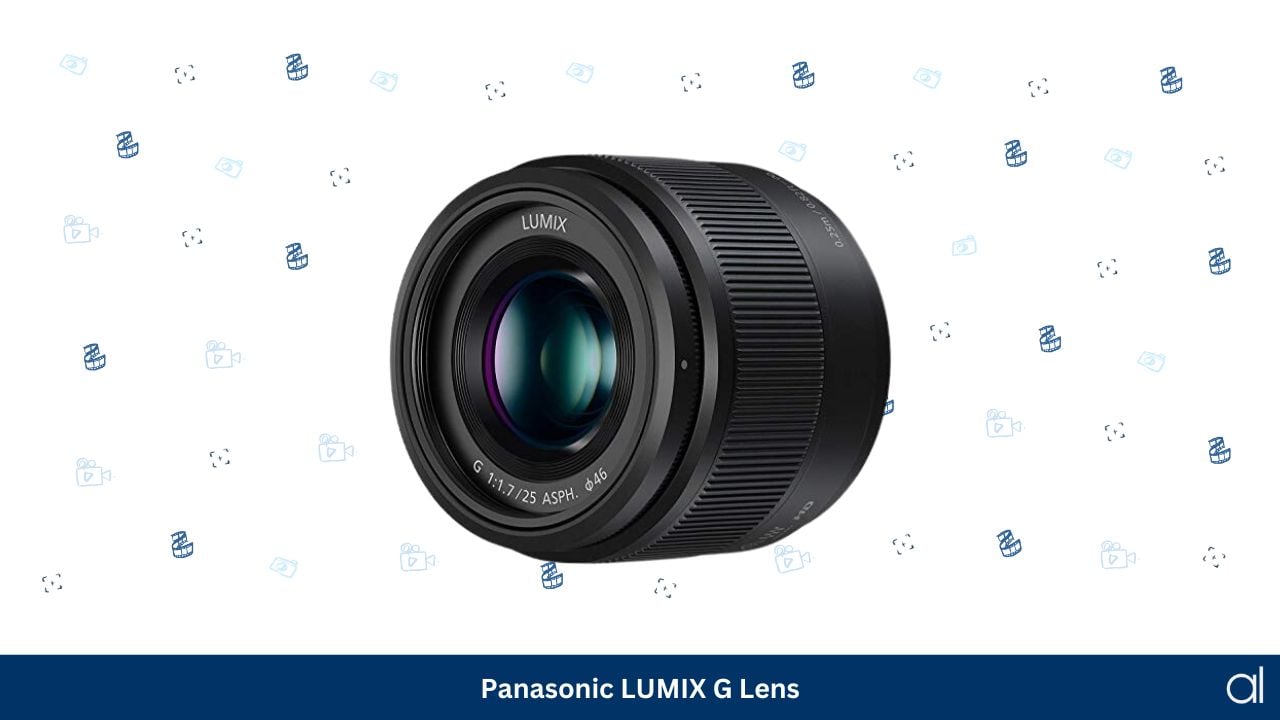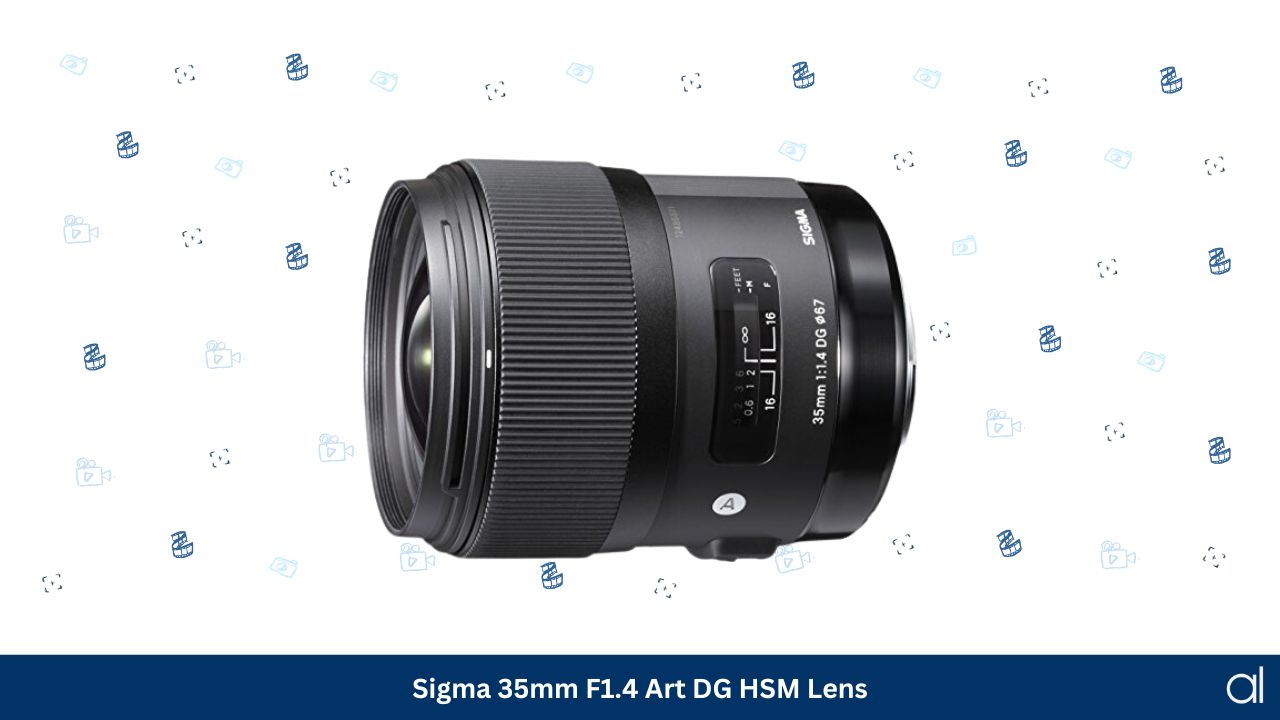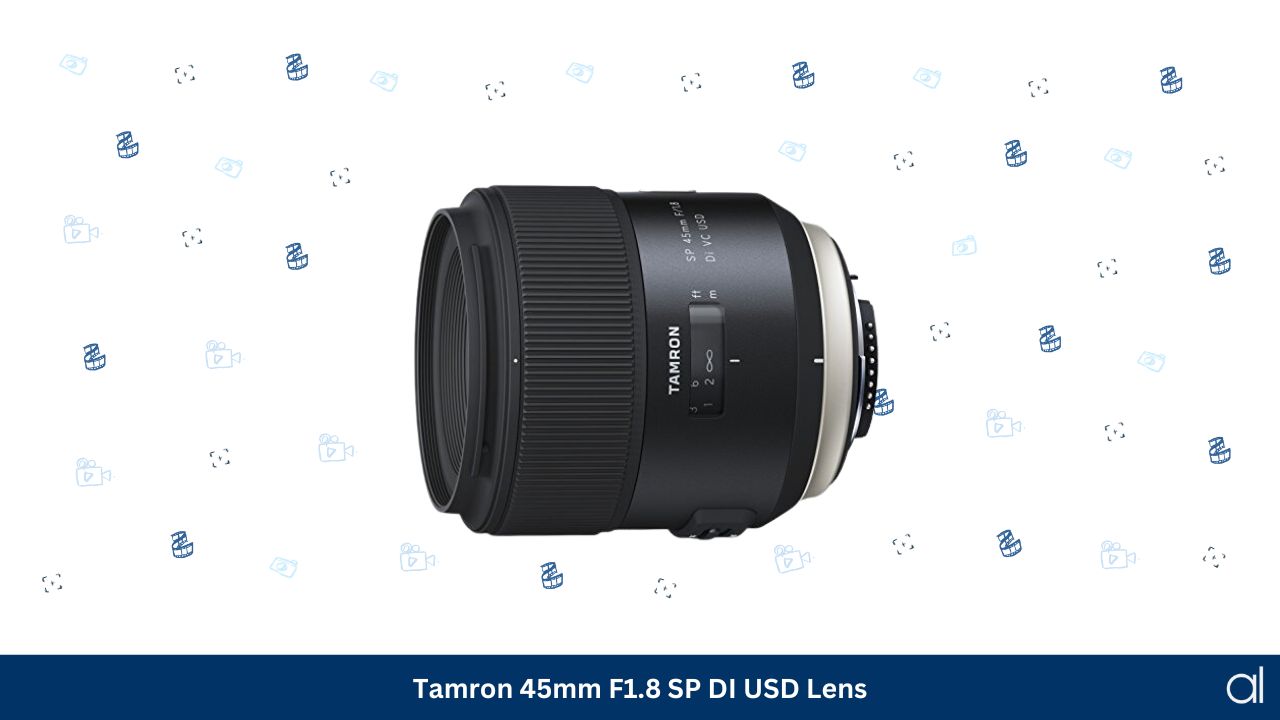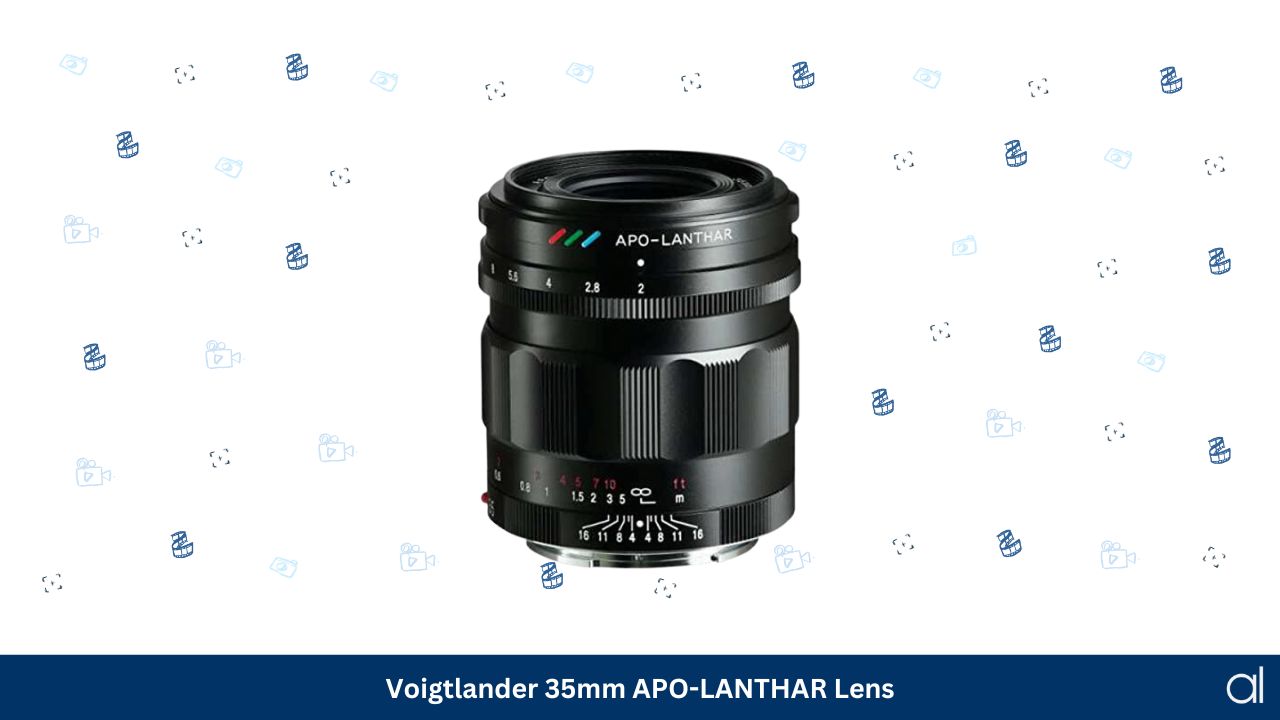At its core, street photography is all about capturing candid moments that tell stories without words.
Thus, a candid picture of the public is at its most effective when taken with precise intent and using the correct lens. Naturally, this demands plenty of flexibility from the camera lens, making it quite difficult to choose one that suits all street photography scenarios.
So, I’ve compiled a list of all the best lenses for street photography that you may use for capturing these priceless moments while out on the street.
Best Lenses For Street Photography
1. Canon EF 50mm f/1.8 STM Lens – Best Overall
The Canon EF 50mm lens is an affordable and portable camera lens featuring a particular emphasis on portraiture and nighttime photography. With a maximum aperture of f/1.8, this lightweight camera lens can be used to capture a high-quality image of your subject.
Featuring horizontal, vertical, and diagonal angles of 40, 27, and 46 degrees, the camera lens can capture action equally as effectively. Moreover, its 80mm effective focal length on APS C cameras and 50mm focal length on full frame cameras give it a wide use case.
You can pair it with the Canon EF lens mount for maximum effectiveness, which can heavily expand its shot variety.
The stepping motor included with this lens offers a continuous move Servo autofocus that is nearly silent. During my time testing the lens, the autofocus was also quite smooth while capturing still architectural images. That said, the lens could have benefitted from image stabilization technology, as it requires a tripod for stable shots.
And lastly, the macro STM lens has a minimum focus distance of 1.15 feet and a maximum magnification of 0.21x. This makes for a lens with a varied use case and plenty of flexibility, making it suited for street photography.
What I Liked
- Consistently high image quality
- Near-silent autofocus
- Lightweight
- Can be used effectively in low light
What I Didn’t Like
2. Nikon AF-S Nikkor 50mm f/1.8G Lens – Best For Mid-Range Street Photography
The Nikon AF-S Nikkor is a portable and lightweight camera lens that features a fully metallic build. It comes with a weather-sealing ring that keeps it from being damaged during harsh weather.
This compact FX-format camera lens features a maximum aperture of f/1.8, along with a 47-degree picture angle of view with the 35mm format. The lens has a larger sensor than the DX-format camera lenses, affording it excellent image quality. It also has a maximum reproduction ratio of 0.15X, a polarizer photographic filter, and a UV protection filter.
With a 50mm focal length and a minimum focus distance of 1.48 feet, the camera lens can be used for portraits and mid-range photography. While testing, I found that it remains particularly effective at capturing the details of an object placed in mid-range.
The Nikkor glass lens has a ring-type autofocus that keeps the image quality high without being too slow. It can also be overridden by twisting the ring, should you need to assume direct control.
In my experience, the outer edges of the image on wider aperture settings do tend to blur a bit. This is a minor issue, as street photography doesn’t often require a wider aperture.
The lens is geared towards well-detailed portraits and mid-range images with plenty of acutance near the center. And that property suits the lens rather well.
What I Liked
- Lightweight
- High build quality
- Good picture quality
- Sharp portraits and mid-range images
What I Didn’t Like
3. Nikon Nikkor Z 35mm f/1.8 S – Best Premium Lens
The Nikkor Z from Nikon is a 35mm wide-angle prime lens that is primarily suited for mirrorless cameras. It is a lens built with a plastic weather seal and remains quite lightweight to carry around easily.
This camera lens pairs particularly well with the Nikon Z camera series that specialize in fast clicks, sharper images, and higher light intake. Its stepping motor is rather quiet, resulting in silent manual and auto-focusing. As a result, the lens produces an image that is highly sharp from one edge to the other.
Adding to the sharp quality of the image is the f/1.8 aperture that helps the lens retain much of its detail. While clicking pictures, I found that elements like color variety, contrast, and chromatic aberration were well-balanced. The colors are accurate, the contrast high, and the chromatic aberration is appropriately low.
With nine rounded diaphragm blades, the lens produces rounded bokeh to divert focus away from your subject. And when paired with a Nikon Z camera, the lens is also capable of reducing vibration, which helps the camera create a crisp image. The lens is also capable of capturing images in any space with low light, making it an option for nighttime street photography or architectural photography.
That said, the lens costs quite a bit of money, making it a significant investment.
What I Liked
- Weather-sealed wide-angle lens
- Sharp and detailed image quality
- Rounded bokeh effect
- Excellent low-light performance
What I Didn’t Like
4. Sony 35mm F2.8 Sonnar T FE ZA – Most Portable Camera Lens
For photographers who need their camera lenses to be as light as possible, the Sony FE may be an option to consider. While not flat enough to be a pancake lens, the Sony lens is portable and light enough to match those qualities of pancake lenses.
This Carl Zeiss brand E-mount lens has a rather discreet profile, which is supported by the aspherical design elements included in the Zeiss Sonnar design. And with an aperture rating of f/2.8, the camera lens can capture an image with a highly sharp center, which suits architecture photography.
You can use the quiet linear motor for autofocus or focus manually using the electronically coupled focus ring. Unlike some other camera lenses, the manual override in the Sony Sonnar aspheric lens is engaged through in-camera menus instead of a twist ring. The Sonnar also supports focus assist and peaking facilities through the in-camera options.
While its image quality is crisp enough, the picture vignette tends to become problematic at maximum aperture. And while the resulting distortion is not particularly egregious, its lack of uniformity makes the picture difficult to correct.
What I Liked
- Highly portable
- High image quality
- Electronically-coupled focus ring
- Lightweight
What I Didn’t Like
5. Fujifilm XF35mmF1.4 R – Best Build Quality
Why Did We Like It?
The Fujifilm XF is a camera lens designed to capture high-clarity images even at the highest aperture. Featuring a maximum aperture of f/1.4, the Fujifilm lens can be paired with a Fujifilm X camera for street photography.
This camera lens comes with a high-quality metal body that remains light enough to be carried around for hours. In the time I spent testing its carry weight, I found that the lens doesn’t add much to the weight of a camera bag. It is simple to store and use, which may suit the fast nature of street photography.
The Fujifilm XF also features a 7-bladed aperture that creates a bokeh effect on images. This effect is applied consistently, even in poor lighting conditions, which can make way for some creative shots. Moreover, its 35mm lens can reduce spherical aberrations and distortions as well, which further adds to its street photography-friendliness.
As I found while testing, the only place where the Fujifilm XF can falter is the focus performance. Its manual focus is rather slow, whereas the autofocus performs both slowly and noisily.
What I Liked
- Aberration and distortion-free images
- High build quality
- Easy to store and use
- Consistent bokeh effect in all conditions
What I Didn’t Like
6. Panasonic LUMIX G Lens – Most Consistent Bokeh Effect Lens
A compact and lightweight lens from Panasonic, the Lumix G is an affordable option to consider for street photography. It can be paired with Olympus and Panasonic Micro 4/3 mirrorless cameras for the best results.
The included Micro Four Thirds technology gives this 25mm camera lens a focal length that is equivalent to a 50mm lens in full-frame terms. Thus, the lens is capable of capturing sharp and high-quality pictures in a variety of situations, including low-light settings.
This camera lens comes with an aperture of f/1.7 at max settings, which is equivalent to f/3.4 aperture in other cameras. Its build consists of eight elements arranged into seven groups, among which is an ultra-high refractive index lens element. What this does is it enables the Lumix G to produce a consistent bokeh background defocus effect.
Once paired with a Lumix G series camera, the Panasonic lens can capture pictures quickly and precisely, enabled by the contrast AF system. And since the lens uses a high-performance stepping motor, the autofocus action is smooth, quick, and quiet.
There is one caveat that I found with the Lumix G lens, which is that the lens case is not weather-sealed. As such, the weather can have an impact on the usability of the Lumix G, potentially deterring you from using it during the monsoon.
What I Liked
- High picture quality
- Smooth, quick, and quiet focus
- Consistent bokeh effect
- Compact and lightweight
What I Didn’t Like
7. Sigma 35mm F1.4 Art DG HSM Lens – Best Autofocus Tracker Lens
The Art-Series lenses from Sigma Corporation are designed to be used for artistic photography, which leans into its functionality as a street photography tool. Built for Nikon cameras, the Sigma DG HSM is an affordable option for those seeking a quick and precise lens.
Featuring an aperture of f/1.4, the Sigma art lens produces a sharp and detailed image in most situations. Because of this quality, I found that its effectiveness was at its highest when shooting landscapes and expansive scenes.
The Sigma lens is capable of tracking your desired subjects through the Hyper-Sonic Motor autofocusing technology. In my experience with the lens, the tracker was quite accurate and easy to use. The autofocus can also be manually overridden if you need precise control over the focusing system.
Additionally, the Sigma DG HSM comes with a 9-blade diaphragm that can create a smooth bokeh effect with 18-point stars. The lens can reduce lateral chromatic aberration using the aspherical elements included in its design, and it can combat lens flares at wide apertures. Having said that, the flares do become noticeable at the highest aperture settings.
And lastly, the Sigma DG HSM is an expensive product, landing it squarely in the premium price range. It is also quite heavy, which can be noticeable in the camera bag or while capturing a picture or video.
What I Liked
- Wide aperture settings
- Hyper-Sonic Motor for autofocus
- Sharp and detailed landscape photography
- Minimal chromatic aberrations
What I Didn’t Like
8. Tamron 45mm F1.8 SP DI USD Lens – Best Low Light Performance
Geared for capturing sharp images, the Tamron SP DI USD is a prime camera lens for capturing images close to the human field of vision. It integrates VC into a 45mm prime lens that is compatible with full-frame DSLR cameras.
The Tamron lens aims to capture crisp images with relative ease from the wide f/1.8 maximum aperture. It can be mounted on Canon Inc. cameras for capturing high-quality images in all settings. And its light build and weather seal make it an option to consider for macro photography and tilt-shift photography.
Images captured using this lens are mostly sharp from one edge to the next. The only time I found a decline in its excellent sharpness was when the lens was wide open, where I observed some vignetting. This disappears as the aperture settings are adjusted.
The lens is able to reduce optical aberration as well, along with measures that minimize ghosting and lens flares. As such, the Tamron lens can be quite clear in most lighting situations.
Tamron uses a ring-type Ultrasonic autofocus system, which is rather slow but accurate nonetheless. If the Ultrasonic motor is too slow for you, the lens includes a manual override that can be activated by twisting the ring.
Lastly, the lens is capable of capturing pictures with high detail and accurate colors in low light as well. For photographers who prefer a nighttime setting, the Tamron lens can be a viable option.
What I Liked
- Performs well in low light
- Lightweight
- Consistently sharp images
- Low optical aberration, ghosting, and flare
What I Didn’t Like
9. Voigtlander 35mm APO-LANTHAR Lens – Best For Distortion-Free Images
Made by the Japanese manufacturer Cosina, the Voigtlander APO-LANTHAR is an ultra wide-angle lens made for mirrorless cameras. The premium lens can be corrected for use with a full-frame image sensor, expanding its usability by a significant degree.
With the Voigtlander, you can capture high-resolution images and experience high-performance optics as well. This results in an image that has plenty of sharpness, high contrast, and accurate colors, which suits street photography well.
The Voigtlander lens can focus on the finer details of distant elements as well, which makes it useful in various situations. It comes with autofocus and a manual override for it, which can help you capture subjects clearly. That said, the manual focus ring can be a little awkward to operate, which makes clicking pictures of moving subjects difficult.
During my time testing the Voigtlander, I found little to no color aberration or distortion in a multitude of settings. The lens works around issues like lens flare, ghosting, light dispersion, and glare, which keeps the image crisp and clear.
You can also create a circular bokeh for point light sources with the circular 12-blade build at most aperture settings. The bokeh effect is decent and can help you create interesting compositions from a different perspective.
And lastly, the Voigtlander camera lens is well-built, giving it high durability and making it weather-resistant.
What I Liked
- Distortion-free images
- High-resolution images
- Circular bokeh effect
- High build quality
What I Didn’t Like
Best Lens For Street Photography Comparison Table
| Best Lenses | Focal Length | Aperture | Compatible Mountings | Lens Type |
|---|---|---|---|---|
| Canon EF 50mm f/1.8 STM Lens | 50mm | f/1.8 | Canon EF | Normal |
| Nikon AF-S Nikkor 50mm f/1.8G Lens | 50mm | f/1.8 | Nikon F-mount (FX) | Normal |
| Nikon Nikkor Z 35mm f/1.8 S | 35mm | f/1.8 | Nikon Z | Wide Angle |
| Sony 35mm F2.8 Sonnar T FE ZA | 35mm | f/2.8 | Sony E | Wide Angle |
| Fujifilm XF35mmF1.4 R | 35mm | f/1.4 | Fujifilm X | Normal |
| Panasonic LUMIX G Lens | 25mm | f/1.7 | Panasonic, Olympus mirrorless | Normal |
| Sigma 35mm F1.4 Art DG HSM Lens | 35mm | f/1.4 | Nikon F (FX) | Wide Angle |
| Tamron 45mm F1.8 SP DI USD Lens | 45mm | f/1.8 | Canon EF | Standard |
| Voigtlander 35mm APO-LANTHAR Lens | 35mm | f/2.0 | Sony E | Wide Angle, Standard |
Buying Guide For The Best Lens For Street Photography
Street photography captures those brief moments on camera that may be missed otherwise. As such, the lens must offer plenty of flexibility to allow photographers to capture these moments without issues.
A large part of which lens you must choose depends upon the camera you have. Not every lens suits each camera, which can narrow down your choices rather dramatically when scouring the market for one. And similarly, not every lens suits every photographer, which comes down to personal preferences and the kind of pictures they wish to capture.
As a beginner, you may feel a little lost when picking a lens for a digital single-lens reflex camera, but you need not worry. There are plenty of criteria to consider when purchasing a street photography lens, which includes its aperture, size and weight, focal length, and more.
Let’s go over each of these in detail to learn what makes for the best camera lens for you.
1. Lens Type
Broadly speaking, there are two main kinds of lenses on the market: prime lenses and zoom lenses.
A zoom lens has a focal length that can be adjusted, whereas a prime lens features a fixed focal length. Of course, the former may seem like the pick since it is more versatile by its very definition, but it is not as simple as that.
The main reason for this is that a zoom lens is typically heavy, long, expensive, and rather conspicuous. These elements make for a street photography or cityscape photography lens that is relatively less effective at its job.
Prime lenses, on the other hand, are smaller, more discreet, and have wider aperture settings, which make them better suited in this case. Moreover, these lenses are relatively inexpensive as well, making them suited for beginners and veterans alike.
And if portability is a priority for you, a pancake lens may suit the task of a lens for street photography as well. Small, lightweight, discreet, lacking a lens barrel, and low-priced, pancake lenses are a flatter and more portable version of prime lenses. They are also a fraction of the size of a telephoto lens.
This increase in portability does come at the expense of image quality, though. The aperture range, in particular, is not as bright as a standard prime lens, which may also pose an issue in certain cases.
2. Focal Length
A lens should be able to capture as much of the scene as possible without distorting the photograph. This is particularly important in street photography, where a wide shot of the scene may be better suited for telling a story.
For this, you will need a lens with a focal length that ranges between 24mm and 50mm. For wider shots, the 24mm view is the most desirable, whereas a 50mm focal length is better for narrower shots. In the middle is the most popular 35mm lens, which offers the best of both worlds while providing you with superb image quality.
At the end of the day, choosing the best focal length range comes down to what you need.
3. Aperture
The higher the aperture range of your camera lens, the more dynamic your shots may become. As such, it is a critical factor to consider when purchasing a lens for street photography. Your camera lens should open up to f/2.8 at the bare minimum, and the brighter your lens goes, the better it will be.
Additionally, the aperture blade construction is an aspect of the lens that is worth considering. As the number of aperture blades goes higher, the bokeh circle improves as well. A good aperture blade construction should be able to produce a gorgeous bokeh in a shallow depth of field.
4. Camera Type
The lens you purchase must have the correct mount to fit your full-frame view camera, particularly if the camera is not commonly used.
A DSLR camera, crop sensor, full-frame camera, mirrorless camera, and point-and-shoot camera – all have different lens requirements. Several photographers have switched from a DSLR camera to a mirrorless model, which renders certain lens types useless.
While some lenses are designed to work with multiple camera types, it may not always be the case. For instance, many DSLR camera lenses can be compatible with mirrorless models using the right adapter. But the same can’t be said for lenses meant strictly for mirrorless models or crop sensor cameras.
As such, it’s important to learn all you can about the lens you’re about to purchase. Check products all across the industry to ensure that you don’t face any issues with camera fit and compatibility.
When should I use a 35mm camera lens for street photography?
35mm is the best focal length to capture images, including a subject and a background, without sacrificing one or the other. It’s no wonder that 35mm lenses are the most popular among street photographers.
If you need to click a picture with multiple subjects and a single background, this lens will suit the task by providing you with exceptional image quality. You can create a multitude of interesting compositions and juxtapositions with the subjects in your picture. And since focusing is easier with 35mm lenses, you will be able to click precise shots without any loss in detail or sharpness.
A 35mm lens will help you fill the picture up with various elements, giving you access to more depth of field in the image. As such, any minor mistakes you may have made while compositing can be covered up quite easily.
Let’s assume you want to keep a subject in focus that is around 10 feet away. A 35mm lens with an aperture of f/8 will keep everything in the immediate vicinity of the subject in focus, including people and buildings. This affords you plenty of room for any mistakes without having to redo or lose the shot, making it a great lens for street photography.
Where is a 50mm camera lens better for street photography?
A 50mm lens is designed to be closer to portrait photography than most other street photography lenses. You can capture your main subject in greater detail in close-up without having to take the surrounding detail into account as much.
With a 50mm lens, you can remain at the minimum focusing distance and take your time to hone in on the subject. While the lens does sacrifice background details for a much crisper singular subject, the results are very much worth it. It also works well for photographing artwork, which needs all the focus to be on the subject.
Street portraits make for poignant shots, and there is no lens better than a 50mm one for it. Your shots will be much more precise and showcase plenty of decisiveness. Additionally, it helps you highlight the expressions, personality, and immediate circumstances of your subject, painting a story that transcends words.
What is the best aperture for street photography?
When it comes to choosing an aperture for street photography, you need to factor in the time of day as well. Generally, f/8 to f/5.6 are the best for daytime photography, while f/5.6 to f/2.8 serve as the go-to aperture settings for night photography.
By using these settings, the lens will produce an image with decent sharpness within a certain distance across the frame. As a result, the background will not be out of focus, and the lights and shadows will be enhanced quite well. This allows you to depict the story of an image as intended.
It’s important to remember that a wide aperture on sunny days can cause your images to become overexposed. So, keep the aperture settings in check with respect to light.
These points also apply to clicking pictures at night, with a few nuances to be mindful of. You may need light from lighting kits to keep the image well-lit, as low-light areas cause cameras to switch to a low shutter speed setting. As such, to get the desired effect, you may want to blur sections of the image in Adobe Photoshop during post-production.
And don’t forget to experiment with the settings based on the light conditions. At night, you can choose an aperture setting between f/5 and f/1.8 to achieve the desired feel for the picture.
Can I use a zoom lens for street photography?
A fast zoom lens can be used for street photography, provided that they cover the required focal length. Typically, a good zoom lens can cover both 35mm and 50mm focal lengths, giving you the flexibility to switch from one focal length to the other.
You will be able to reframe your shot without moving much, which is something a prime lens can’t achieve. Additionally, a zoom lens has a constant aperture that gives you the opportunity to click pictures at the drop of a hat. Simply twist the zoom ring to readjust the shot and click the picture.
Another advantage of a zoom lens is that you don’t need to carry multiple lenses around. Switching between focal lengths and settings is quick and easy, eliminating the need to switch the particular lens out completely.
Conclusion
Street photography is all about spontaneity, and the lens plays a major role in determining how much a street photographer can capitalize on said spontaneity. As such, the importance of choosing the right camera lens for street photography cannot be understated.
From my experience testing the products, I found the Canon EF 50mm to be one of the best lenses for street photography overall. This lens is capable of producing high-quality images while being lightweight, silent, and effective in various scenarios. The Canon EF is a versatile pick for street photographers with a penchant for portraiture.
That said, other first and third-party lenses like the Nikon AF-S Nikkor and the Nikon Nikkor-Z are also some of the best lenses for street photography. Choosing between the best street photography lenses comes down to what you need from the lens and your personal preferences.
Related Articles
19 Best Lenses for Landscape Photography
7 Best Lenses for Building Photography
13 Best Continuous Lighting Kits for Photography
6 Best Protection Filters for Lenses
7 Best Canon Lenses for Architectural Photography
7 Best Sony Lenses for Architecture Photography

